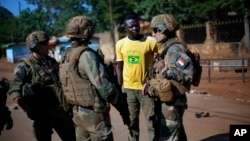Just over a year ago, the Central African Republic appeared to be on the verge of a genocide. A prompt intervention by French forces halted mass killings in the capital, and violence there between Muslims and Christians or animists largely subsided in 2014. But inter-communal violence continues elsewhere in the country, and peacekeepers cannot establish peace on their own.
The French operation Sangaris, named after a type of butterfly, was not meant to last indefinitely.
There are currently 2,000 French troops in the Central African Republic and that number will drop closer to 1,500 over the coming months as the U.N. mission, MINUSCA, builds up from its current level of about 8,500 troops and police to 10,0000.
Sangaris has a battalion of some 500 men in Bangui who continue to patrol potential hotspots. On a recent night, VOA accompanied one of these patrols.
A sub-lieutenant who gave his name as Maxence explained that the Sangaris' mandate is to act in support of MINUSCA, and that normally Central Africans report security problems to their own police or MINUSCA, who then call on Sangaris when they need help.
The French have night vision equipment and heat-seeking weapons enabling them to identify and neutralize concealed targets at any hour of the day or night. Former militiamen have told VOA they are afraid of the French and try to avoid them.
That same night, another officer by the name of Bruno was leading a foot patrol on a road dividing Muslim and Christian communities in Bangui. He said the area was deserted a year ago but that people have been coming back gradually. The problem there now is gangs of youths who steal from abandoned houses and sometimes fire shots to scare people away, said Bruno.
Quick response by France
The French government authorized Sangaris to deploy immediately after mass killings started in Bangui last December, and within 24 hours there were more than 1,000 French troops in the city. At the time 100 or more people were being killed each day.
A local community leader told VOA the French reacted quickly to calls for help. He said you could call them and they would be there within 10 minutes.
He said he was sorry French troops were no longer able to deploy permanently in his neighborhood but admits the insecurity there is now a policing problem. Sangaris is not a police force.
Violence spiked in the capital in October but since then has been at a low level, said Colonel Philippe Testart, commander of the Sangaris battalion in Bangui.
"It is the same level of violence as in our Western capitals, you know. It is [a] basic type [of] violence -- car jackings, attempted killings for money and things like this - but it’s only one or two per night or day," said Testart.
However, inter-community violence has been on the rise elsewhere in the country. In the past week there have been reports of at least 18 people killed and dozens injured in and around Gamboula and Nola near the western border, of at least 20 killed and dozens injured in tit-for-tat attacks in the central region of Bambari, and of 28 killed in the southwestern area of Mbres.
Most of these incidents seem to have occurred in rural areas and the figures are still being verified, MINUSCA’s chief of staff, General Frederic Hingray said.
The general said the mission has seen some graves at Mbres - tangible evidence for the reports from that area - but the number of graves does not correspond to what was reported, and so far only a handful of the 28 alleged deaths at Mbres have been verified.
Asked by a journalist why the violence was continuing despite MINUSCA’s presence, he said this was like expecting firemen to stop fires before they break out.
A Sangaris spokesman told VOA the solution to the CAR crisis is no longer military but involves politics, economics, security and the judiciary.








